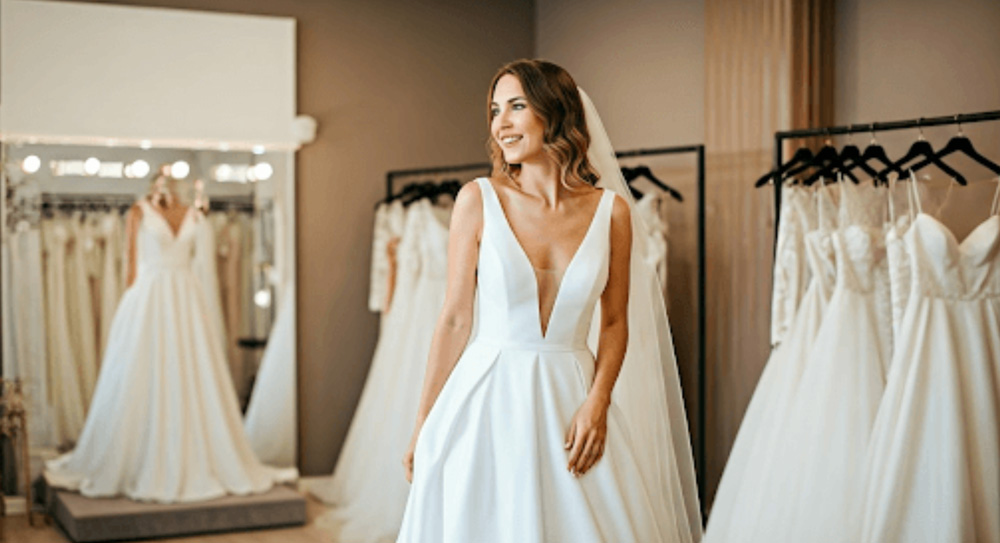Key Highlights
- The first step is to understand your personal style, body type, and wedding theme
- Set a realistic budget to guide your choices without compromising your vision.
- Gather inspiration from Pinterest, magazines, and bridal shows to spark your imagination and inform your decision
- Try on different wedding dress styles and silhouettes to find the perfect fit
Introduction
We’ve all had childhood fantasies about our wedding dress – the flowing fabric, delicate lace, and the sparkle of the intricate beadings. But as magical as these daydreams are, the reality of finding the perfect wedding dress can feel overwhelming. With so many options, styles, and details to consider, it’s easy to get lost in a sea of tulle and silk.
In this guide, we’ll take you through the steps of finding your dream wedding dress. You’ll learn how to collate your dress ideas, find bridal stores that stock your dream dress, and how to choose the right fabric for your big day. Ready? Let’s get started!
Understanding the Basics of Wedding Dress Selection
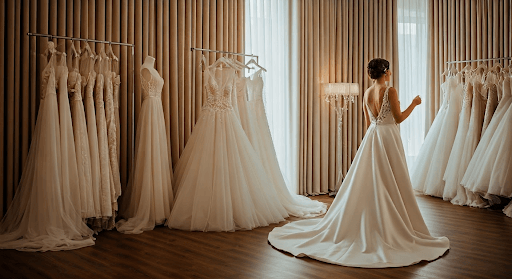
Before you start your search, think about the vision you want to create. What type of bride are you, and how will you define your style? Do you want to be a modern, romantic, or bohemian bride? Whatever style you choose should match your wedding theme so that you can tell a consistent story.
Similarly, your gown should be an extension of your personality. From the fabric to the bodice and embellishment, each element should harmonize beautifully to create a look that’ll make you feel like the best version of yourself on your wedding day.
For example, if you prefer minimalism and want a simple wedding, a classic A-line gown with lace detailing will do the trick. But if you’ve always dreamt of an elaborate wedding with a touch of grandeur, a ball gown adorned with intricate beading and a flowing train is the way to go.
Another thing you need to consider is your body shape. While you’ll be faced with multiple options that pique your interest, it’s (always) best to go for a gown that accentuates your figure. A good way to do this is to reflect on your favorite dress from your current wardrobe. What makes it so special? Is it the neckline, sleeve, or silhouette? Whatever it is, combine the best features of your everyday wear to create a vision for your wedding dress.
The Step-by-Step Guide to Finding Your Dream Wedding Dress
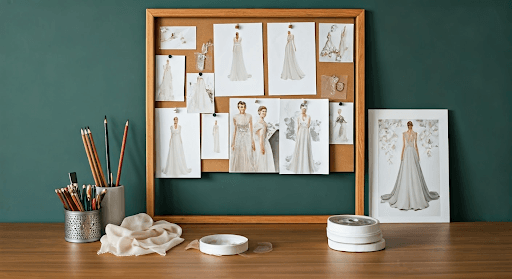
Now that you have done the prep work, it’s time to find your dream wedding dress. Here are seven tips to help your search:
Step 1: Create a mood board with your inspirations
The first thing you want to do is create a mood board of your inspirations. If you’re using Pinterest, create a “My Wedding Dress Inspiration” board and pin as many dresses as possible to catch your eye. Add accessories, hairstyles, veils, makeup, or anything else that shows the theme you want to have on your big day.
You can also:
- Check bridal magazines,
- Watch runway shows,
- Check wedding dress hashtags on social media or
- Go to local bridal shows
… to expand your search. Pay close attention to details like the neckline, fabrics, embellishments, sleeves, and other elements you’ll love to replicate on your wedding gown.
Once you’ve found the dresses you like, compile them on a mood board and look for commonalities in the styles. Are most of them long-sleeved? Floral? A-line? This will help you build a clearer vision of the styles you want to replicate in your dress. This is an example created on Canva:
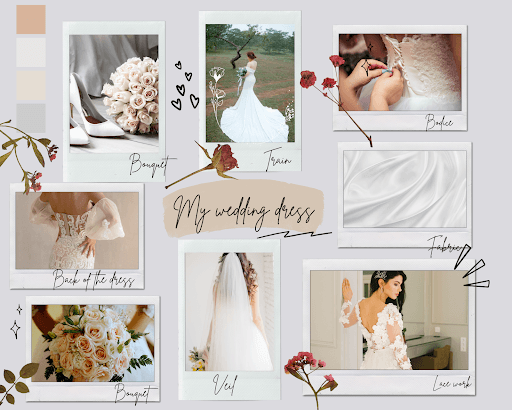
Next:
Step 2: Find bridal stores that stock similar dresses
Once you have a theme/style, it’s time to search for bridal stores that stock your dream dress.
Run a quick search on Google, and you’ll find hundreds of bridal stores in Auckland, each with its own specialties. Focus on the ones with a good reputation, quality customer service, and an extensive stock of wedding gowns that match your style. For example, if you want a modern, contemporary look, find designers that specialize in this niche.
You can also upload your dress ideas on Google Lens to show specific sites that list the exact dress you want or have similar options. Before contacting them, ensure you measure yourself correctly and benchmark your measurements against the designer’s size chart.
Or, if you want to build your design from scratch, consider using a bespoke bridal dress service. Bespoke bridal services offer a personalised experience where you can collaborate with designers to create a unique gown tailored to your vision.
For instance, even though we stock designer ready-to-wear wedding gowns from Europe’s best designers at Alter Me, we also offer bespoke services for brides who couldn’t find their dream dress off-the-rack.
However, whether you want to buy a ready-to-wear wedding gown or bespoke, always opt for a designer that:
- Cares about your needs as much as you do,
- Understand your style and, most importantly,
- Has the skills/capabilities to create/find a dress that makes you feel like YOU.
Also, keep in mind that popularity doesn’t always equate to quality/expertise. Spend time researching the designer or store to ensure they are experienced and use quality fabrics for their wedding dresses. Here are some tips that help:
- Look out for their reviews on Google Business Profile. Typically, a reputable store will have plenty of good reviews and a few bad ones as well. If the store has only good reviews or no reviews at all, it’s a red flag.
- Also, look at 5 – 10 reviews to see how past customers described their services. Some business owners pay for reviews, and the best way to know this is to check the patterns in the feedback, such as similar words across reviews or generic comments. A good review will be descriptive, like this:
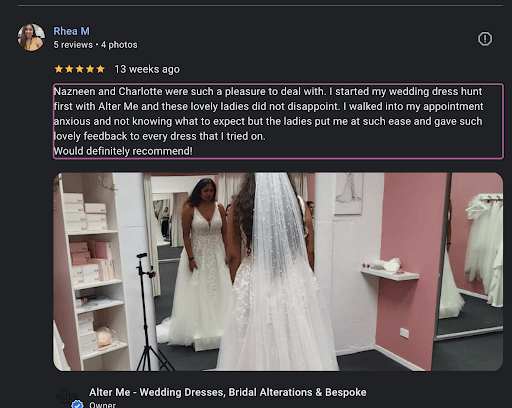
Also, check out pictures from previous brides. This gives you an idea of how the dress looks in real life. You can find this in the “Brides” section of the website:
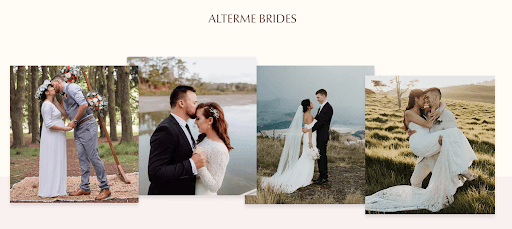
Step 3: Set a budget
You also need to consider your budget.
Several things can drive up the cost of a wedding dress. This includes the designer, fabric quality, amount of alterations needed, embellishments, etc. If you find a store that lists your wedding dress, call them first to know how much it costs to sample and buy the gown. The last thing you want is to find the perfect gown but only to find out it’s way beyond what you hoped for.
Also, don’t forget to consider costs for alterations, accessories like veils, shoes, and jewelry, and any taxes or shipping fees. For example, say you have a budget of $3000 for your wedding dress. Don’t search for dresses within this price range unless you already have a separate budget for accessories and alterations. Instead, factor all the associated costs into your budget to maximize your spend.
Read more: How much does a wedding dress cost?
Step 4: Choose the perfect dress for your body shape
Another important thing to consider is your body shape.
There are different body shapes, and understanding yours can help you find the style that’ll flatter your silhouette best. For example:
- Hourglass shape: Mermaid, A-line, trumpet gowns
- Pear/Triangle shape: A-line, Ball, or trumpet gowns
- Inverted triangle: Mermaid or fit and flare gown
- Petite: Mermaid, sheath, short or trumpet wedding dresses
- Rectangle: Short or A-line dresses.
Some brides make the mistake of buying dresses online without consulting a stylist or trying them on before purchase. While it’s easy to be drawn to a specific dress based on its appearance in photos, this approach can cause disappointment if the dress doesn’t fit well or complement your shape.
To avoid this pitfall, take the time to research which styles work best for your body shape. A better option is to schedule an appointment with a bridal stylist who can offer personalized advice and help you find dresses that enhance your natural silhouette.
Tip: If you buy a ready-to-wear dress, look for one that’s an exact match in size or slightly bigger. This is more important if you’re only a few months from your wedding. Don’t buy a smaller-sized dress with the expectation of losing weight before your wedding. Even if you plan to shed some weight, you can always alter a bigger gown to fit rather than the other way around.
Read more: How to choose a wedding dress for your body shape.
Step 5: Schedule fittings and alterations
Once you’ve finally found the “perfect” dress and designer/bridal store, it’s time for fittings and alterations, if necessary. Except you’re lucky, it’s (very) rare to get a dress in your exact size. This is why you need alterations. Plus, if you want to add custom embellishments, change the sleeves, or shorten the train, you’ll need a skilled sewist to tailor the dress to your taste.
Most bridal stores usually offer more than one fitting session to ensure the gown remains a perfect fit before your big day. If you want to customize the gown or need alterations, you can easily discuss the options with your stylist during the fitting process.
Step 6: Plan for the preservation of your dress post-wedding
After your special day, taking care of your wedding dress is important. Proper preservation helps to prevent discoloration, fabric damage, etc.
Bridal stores like Alter Me offer dress storage and preservation services, so you can store your dress to keep it in pristine condition for years to come. Proper preservation helps prevent discoloration, fabric damage, etc.
If you’d rather DIY (do it yourself), dry clean it immediately after your wedding. Once cleaned, store your dress in a cool, dry place, ideally in a breathable cotton or muslin garment bag for easy air circulation. Avoid plastic bags, as they easily trap moisture and can cause fabric discoloration over time. Also, if your gown is a cherished family heirloom and you want to keep it for generations to come, consider investing in a preservation box that is acid-free and designed for long-term storage.
Key Considerations When Choosing Your Dress
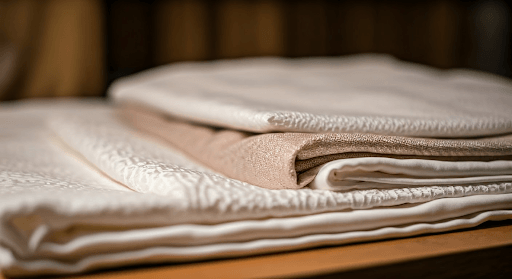
When picking your wedding dress, the silhouette and style might steal the spotlight, but there’s a whole lot more that goes into finding the one. Let’s talk about those less obvious yet super-important factors that make your dress not just stunning but perfect for you:
1. Fabric & Comfort
Fabric plays a huge role in how your dress feels and moves. Think about your big day: hours of hugging, dancing, and maybe even running for the bouquet toss. You’d want your dress to allow you to engage in all activities and not just sit like a visitor at your wedding. Thankfully, most bridal boutiques usually give fabric recommendations. Here at Alter Me, we have style experts who will guide you on which fabrics work best for your comfort.
For instance, fabrics like satin or silk are smooth and luxurious but can be a bit heavy — work best if you don’t intend to engage in many activities. On the other hand, lighter fabrics like chiffon or tulle are airy and flowy, which is perfect if you want to move around.
Pro tip: Try to dance or sit in your wedding dress to test its comfort.
2. Season of your wedding
Another key factor to consider when choosing your wedding dress is the season the big day falls in. For a spring or summer wedding, you may opt for lighter fabrics like chiffon, tulle, and organza. These fabrics have an airy, soft flow that fits well with warm weather and outdoor settings, creating a light, romantic vibe.
If your big day falls in winter, heavier fabrics like satin, silk, or velvet will be perfect. They provide structure and complement the colder atmosphere with their rich, luxurious look. For fall weddings, you can go with mikado silk or crepe fabrics, which offer a balance of warmth and elegance.
The season will influence not only your fabric choice but also the overall theme of your wedding dress.
3. Wedding Venue and Theme
The location and overall theme of your wedding can help you decide on the style, fabric, and length of your gown. Is it a beach wedding? A ball gown might feel out of place (and heavy in the sand). A grand ballroom? A structured ball gown or A-line dress will be more fitting. Tailoring your dress to the vibe of your venue ensures you’ll look like you belong in the scene, not like you accidentally wandered in.
4. Details of bridal sizing
The importance of bridal sizing cannot be overstated when choosing your wedding dress because it directly impacts how it fits and flatters your body.
Unlike regular clothes, bridal sizing is often smaller, so the size you wear in every day clothes may not match your wedding dress size.
For example, if your regular dress is a size 8, it may translate to a size 10 or 12 in bridal gowns. The right size translates to the dress fitting perfectly in key areas like the waist, bust, and hips, which allows the fabric to flow as intended. A dress that’s too tight can cause discomfort and affect the silhouette, while a dress that’s too loose may lack structure and shape.
Some brides opt for custom sizing to ensure the gown fits like a glove (though it can be more costly). Nevertheless, you can always alter the dress to your perfect size.
Understanding Bridal Sizing in New Zealand
Bridal sizes are often different from regular clothing sizes. When you shop for a wedding gown in New Zealand, it’s important to check the sizing charts used by bridal boutiques and designers.
Don’t be shocked if you need a larger size than you usually wear; this is common in the bridal world. The key is to find a dress that feels good and can be tailored to fit your body perfectly. Also, don’t focus too much on the size of the tag. A skilled sewist can make amazing adjustments to ensure your gown fits beautifully, no matter what size you start with.
Importance of Fabric and Seasonality
The fabric of your wedding dress affects its style and comfort. When choosing fabrics, it is important to consider the season. Choose lighter fabrics like chiffon, organza, and tulle for spring and summer weddings. These fabrics allow for airflow and have a lovely fall. For fall and winter weddings, go for heavier materials. Satin, velvet, and mikado can keep you warm and add a touch of luxury.
Tips for a Stress-Free Dress Shopping Experience
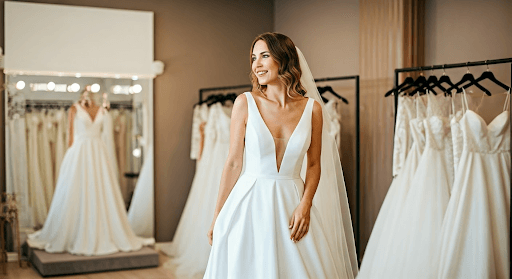
Finding your dream dress should be fun and unforgettable. Here are some tips for hitch-free wedding dress shopping:
Why Bringing Proper Undergarments Matters
Don’t overlook the importance of wearing the right undergarments for your dress fittings.
The foundation pieces you pick can greatly change how a dress fits and highlight your figure. Make sure to wear seamless nude underwear and a good strapless bra if needed at your appointments. This helps create a smooth look for the dresses and shows how they will appear on your wedding day. If you already have a stylist, ask for suggestions for what to wear for your dress fittings.
The Role of Footwear in Dress Selection
When you go to fittings, bring shoes similar in height to what you want to wear on your wedding day. This is important because shoes affect how you stand and walk and how the dress looks.
Wearing the right heel height helps you get better alterations and ensures the dress sits at the right length. Walking around the salon in your shoes will also help you see how comfortable they are for standing and dancing all day. Feel free to try different shoe styles and heights until you find the right match for your dream dress.
Conclusion
Finding your dream wedding dress can be fun, with many feelings and choices. In summary:
- Know your wedding theme and pick the right style for you.
- Make a budget that works for you. This helps a lot when looking for a dress.
- Create a mood board and check out different stores.
Don’t forget to prioritize fittings to get the best fit for you. Enjoy the experience and trust yourself to choose the dress that makes you feel special on your big day. With some planning and care, your dream wedding dress awaits you and will make your wedding day even more special.
Frequently Ask Questions
How Long Before the Wedding Should I Start Dress Shopping?
It’s a good idea to start dress shopping 9 to 12 months before your wedding day. This time frame gives you plenty of time to look around, place your order, and make any necessary alterations.
What If I Can't Decide Between Two Dresses?
If you can’t decide between two dresses, check with your bridal salon to see if you can book another appointment to try them on again. Having an open mind and getting thoughts from a friend you trust can help you make the choice clearer.
How Much Should I Expect to Alter My Wedding Dress?
Alteration costs can vary depending on the complexity of the work. It’s best to spend about $300 to $800 on alterations.
Can I Change My Dress If I Have a Change of Heart?
Most bridal stores do not allow returns. However, it is a good idea to ask about whether they offer exchanges or store credit.

